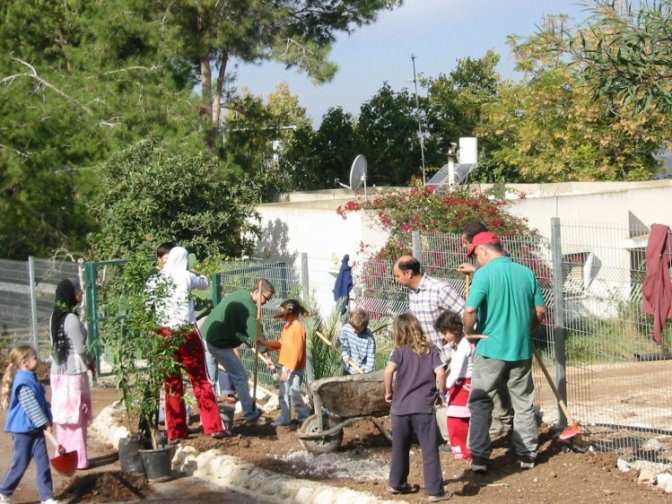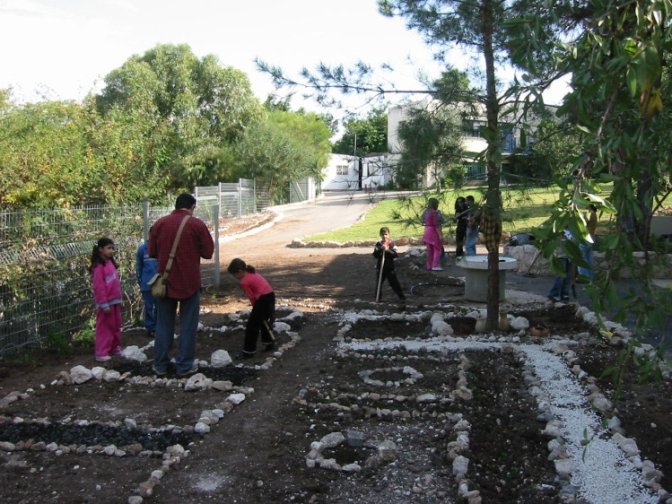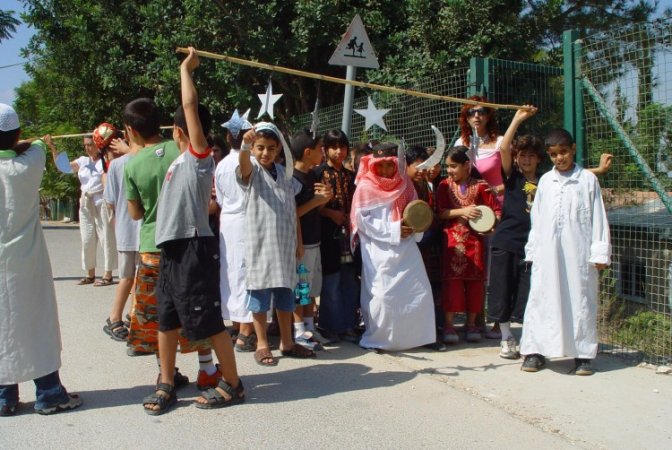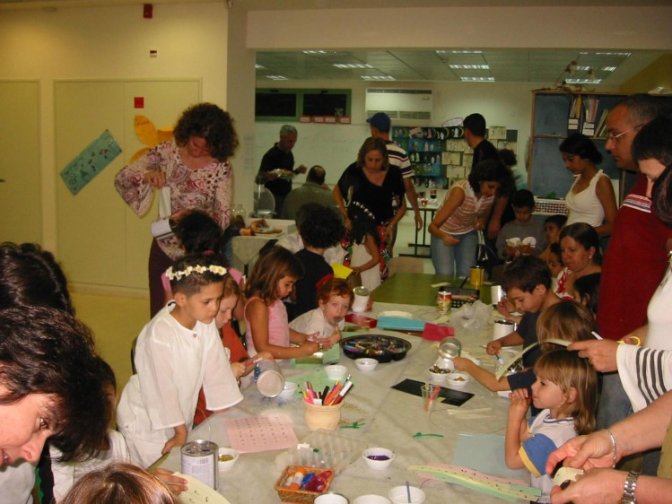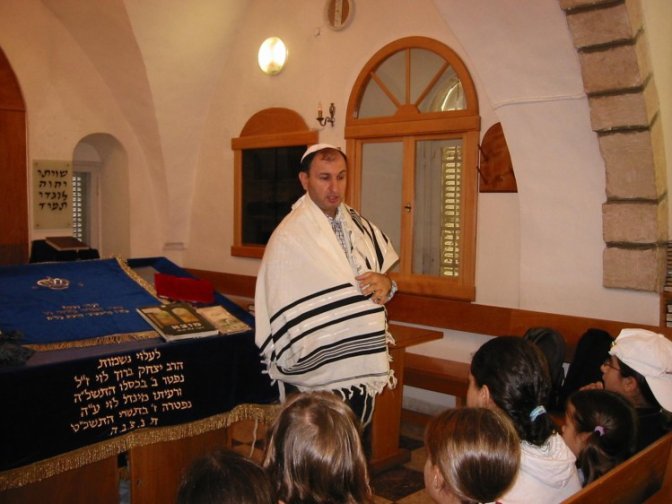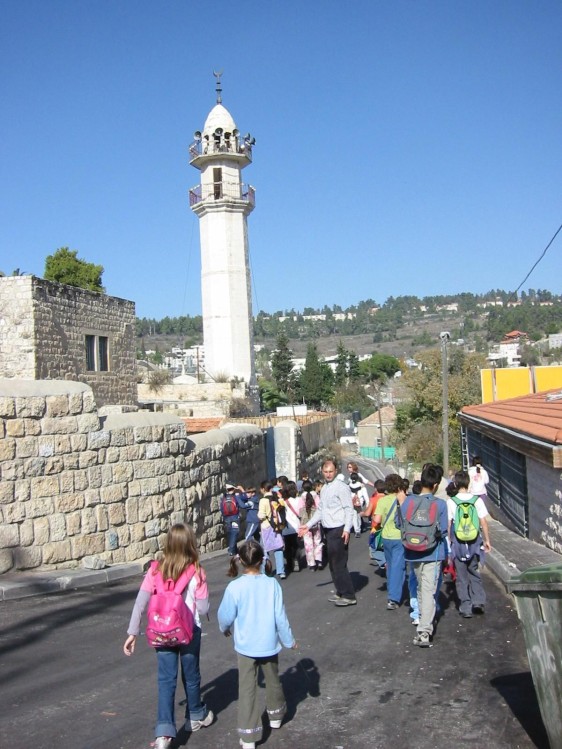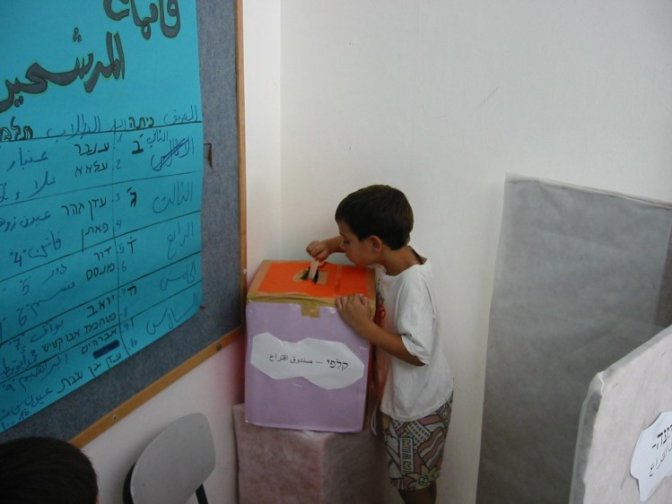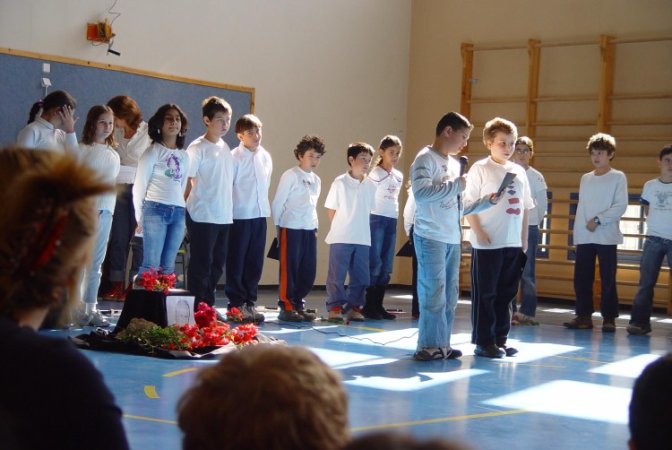Home > Oasis of Peace > Projects & Outreach > Children’s Educational System > Little stories
Little stories
Tuesday 13 December 2005, by
All the versions of this article: [عربي] [English] [עברית]

As I write, it’s almost December and behind us are three months of creativity, work and small stories of everyday life.
It is hard not to mention the surprise that awaited the school children on September 1, the first day of term. The fenced-in and ugly building site they had seen during the last year was suddenly become a wonderful new school building, surrounded by a green lawn.
The children could hardly manage to keep from treading on the latter – which was still too new to endure the passage of many small feet: for a whole month they looked at it longingly, and now a morning doesn’t go by without them joyfully rolling in the grass.
The new building added much space, light and colour to the school. The area set aside for the first grade class earned the nickname among the children of “the royal suite”, and the whole school community of teachers, parents and children were caught up in the general enthusiasm. One Friday they came to prepare beds for gardens, to sow seeds and plant seedlings (1). Every classroom received its own small plot, which the students look after and irrigate.
It is touching to see the children going to check what has sprouted in their own plots (2). There is also a new greenhouse, where the children learn the process of growing plants from seeds to maturity in the garden (3).
This year, Leora Erez and Faten Alzinati were appointed as social coordinators at the school. At the beginning of the school year, they presented a yearlong plan to the staff that included school activities around the festivals and various events. The first decision adopted was that each holiday would be handled by a different home-room teacher and class. The teacher and class would take responsibility for all the activities in the school as the holiday approached. Thus, the second grade class has presented the Festival of the Cross, fourth grade presented Ramadan (4), sixth grade, Rosh HaShanah (5), and first grade will soon present Christmas. The presentation of the holiday with dance, song and drama in the two languages enables all the children to learn about the holiday also in a visual way.
On the same subject, at the beginning of October, the first grade children received a workbook on the subject, “culture and tradition”, that was compiled by Diana Shalufi Rizek and Eti Edlund. The workbook includes material on the holidays of the three religions, Hebrew and Arabic language support and associated vocabulary, as well as many enrichment activities. Parents and teachers of second grade pupils requested that they will receive the workbook too, and so we have distributed it to them.
The subject of the holidays very much occupies the staff as well as the parents. During the Muslim month of Ramadan, several classes dined together with parents at the Iftar (the meal that breaks the fast), and in the first grade we integrated the meal with activities for the Succot Jewish holiday (6).
Also apropos of the holidays, fifth grade pupils traveled to two villages where some of the children live: Motsa (a Jewish town) and Abu Ghosh (an Arab town). The visit focused mainly on places of worship.
In Motsa, the children visited an ancient synagogue and learned from a parent about the Holy Ark (which contains the biblical scrolls), about the Torah, and about the significance of phylacteries (7).
In Abu Ghosh, the children visited the 12th century Crusader church (which is still functioning). Teachers explained some of the differences between the Jewish, Christian and Muslim religions, all of which are represented at the school (8).
Still in Abu Ghosh, the children were invited to the mosque, and heard a discussion of Muslim customs and the five tenets of Islam (9).
In September, elections took place for the class committees and the student council. The elections were an exercise in democracy. The candidates were each given the stage to present their own political platform. The children prepared slogans and posters and visited all the other classes for their election campaign. Finally, an election box was prepared and each class chose its representatives (10).
The student council began its work enthusiastically. Together with two teachers (Liora and Faten) each class initiated activities popular with the children. For example:
Once a week, members of the council prepare “an Arabic-only school break”, for which they arrange activities and encourage all children to speak in Arabic (11).
Once every two weeks, the children arrange an “active school break” on a certain theme: the children plan activity stations which all the children visit (irrespective of grade level).
On November 13, the school arranged a study week on the subject of democracy. Beginning from the first grade, the students learned about every person’s right to express their opinion, as long as it does not disparage, insult or trample on the rights of others to live with dignity and in peace. The study week was connected with the tenth anniversary of the assassination of PM Yitzhak Rabin, for which the first grade students made a special presentation.
In the past year, a very interesting connection has been built up between our school and the Woodstock Primary School in Oxford, UK. The first practical steps in this relationship were to draw up a detailed activity plan and decide which classes would work more directly with the other school. Already the two schools have exchanged information and pictures, and the relationship provides an opportunity for our students to learn English and about the customs of the children and school in Oxford. The Oxford children learn from us about the coexistence between Jews and Arabs and about the rich cultural world of the two peoples and three faiths represented here.
Certainly there are many other wonderful stories that have not been told here, and we have not even talked about our plans for the future... But it is impossible to conclude without mentioning the new friendships that have developed between first graders Nir and Sayid, between Ella and Hanin, and between many other children who manage to break down the walls of their differing cultures, religions, languages and ethnicity. Here, in this small and green place, these walls come tumbling down.
